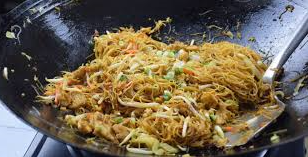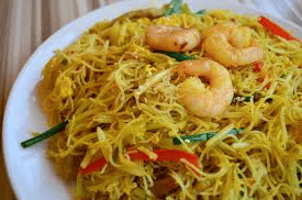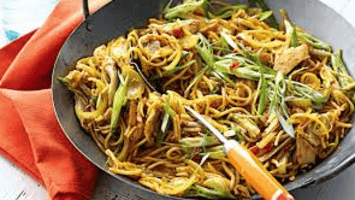Have you ever found yourself craving a dish that’s both comforting and exciting? Something that combines the perfect balance of spices, vegetables, and protein?
Look no further than Singapore Rice Noodles, a beloved staple in Asian cuisine that has captured the hearts and palates of food enthusiasts worldwide. Despite its name, Singapore Rice Noodles actually originated in Cantonese cuisines from Hong Kong, inspired by the multicultural flavors of Singapore.
Whether you’re an experienced cook or a beginner in the kitchen, this comprehensive guide to making authentic Singapore Rice Noodles will help you master this iconic dish that’s perfect for weeknight dinners or special occasions.

What Makes Singapore Rice Noodles Special?
Singapore Rice Noodles stand out from other noodle dishes due to their distinctive yellow color and aromatic flavor profile, both attributed to curry powder—the signature ingredient that gives this dish its unique character.
What makes this Singapore Rice Noodles recipe truly special is how it combines proteins like shrimp, chicken, or char siu (Chinese barbecued pork) with crisp vegetables and eggs, all tied together by that distinctive curry seasoning.
The Origins and History
The story of Singapore Rice Noodles is a fascinating example of culinary cross-pollination. Despite their name suggesting Singaporean origins, these noodles are rarely found in Singapore itself! They were created by Cantonese chefs in Hong Kong who were inspired by Singapore’s spice-forward cooking traditions.
The dish gained popularity in Chinese restaurants around the world, particularly in Western countries where it became a takeout favorite. The Singapore Rice Noodles recipe evolved as it traveled, with each region adding its own twist while maintaining the core elements of curry-flavored rice vermicelli with a mix of proteins and vegetables.
Today, Singapore Rice Noodles are celebrated globally as comfort food that’s both accessible and exotic.
Equipment Needed
Basic Equipment:
- Wok or large frying pan
- Large bowl for soaking noodles
- Colander for draining
- Sharp knife
- Cutting board
- Measuring spoons and cups
- Wooden spoon or spatula
- Small bowls for ingredient preparation
Optional but Helpful:
- Garlic press
- Microplane or grater for ginger
- Kitchen scissors for cutting noodles
- Tongs for tossing noodles
Ingredients for Singapore Rice Noodles
For the Noodles and Proteins:
- Rice vermicelli noodles (8 oz/225g)
- Shrimp, peeled and deveined (4 oz/115g)
- Boneless chicken breast, thinly sliced (4 oz/115g)
- Chinese roast pork/char siu, thinly sliced (optional, 4 oz/115g)
- Eggs (2, beaten)
For the Vegetables:
- Red bell pepper, thinly sliced
- Green bell pepper, thinly sliced
- Yellow onion, thinly sliced
- Carrots, julienned
- Bean sprouts (2 cups)
- Green onions, chopped
- Fresh cilantro for garnish
For the Sauce:

- Curry powder (2 tablespoons)
- Soy sauce (3 tablespoons)
- Dry sherry or Shaoxing wine (1 tablespoon)
- Sesame oil (1 teaspoon)
- Sugar (1 teaspoon)
- White pepper (1/4 teaspoon)
- Chicken or vegetable broth (1/4 cup)
For Aromatics:
- Garlic cloves, minced (3)
- Fresh ginger, grated (1 tablespoon)
Step-by-Step Instructions
Preparation Phase:
- Begin by soaking the rice vermicelli noodles in warm water according to package instructions, usually about 10-15 minutes until they’re pliable but still slightly firm.
- After completely draining in a colander, set aside.
- This proper preparation of noodles is crucial for your Singapore Rice Noodles recipe to achieve the right texture.
- While the noodles are soaking, prepare all your proteins and vegetables.
- Having everything cut and ready before cooking (mise en place) is essential, as the actual cooking process for Singapore Rice Noodles happens quickly.
- Combine all sauce ingredients in a small bowl, mixing well to ensure the curry powder dissolves completely.
- The vibrant yellow color from the curry powder will become more pronounced as it cooks with the other ingredients.
Cooking Process:
- Heat 1 tablespoon of oil in your wok or large frying pan over high heat until it begins to shimmer.
- Add the beaten eggs and quickly scramble until just set but still moist. Remove and set aside.
- Add another tablespoon of oil to the wok.
- When hot, add the shrimp and chicken, cooking until the shrimp turns pink and the chicken is no longer pink inside.
- If using char siu pork, add it now just to warm through.
- Remove the proteins and set aside.
- Add a bit more oil if needed, then add the aromatics—garlic and ginger—stirring quickly until fragrant but not browned.
- Immediately add the vegetables (except bean sprouts and green onions), stir-frying for about 2 minutes until they begin to soften but remain crisp.
- Lower the heat to medium and add the drained rice noodles to the wok.
- Pour the curry sauce mixture over the noodles and toss gently but thoroughly to coat every strand with the vibrant sauce.
- The noodles will absorb the flavors and take on that signature yellow color of authentic Singapore Rice Noodles.
- Return the cooked proteins and scrambled eggs to the wok, along with the bean sprouts and green onions.
- Gently toss everything together to combine well and heat through.
- Taste and adjust seasoning if necessary, adding more soy sauce or a pinch of salt if needed.
- Transfer your Singapore Rice Noodles to a serving platter, garnish with fresh cilantro, and serve immediately.

Tips for Perfect Singapore Rice Noodles
Noodle Preparation:
- Do not oversoak your rice vermicelli as they will continue to cook when stir-fried.
- They should be pliable but still have a slight resistance when you test them.
- After draining, you can snip the long noodles with kitchen scissors a few times to make them easier to stir-fry and serve.
Wok Technique:
- Use high heat and work quickly.
- The secret to great Singapore Rice Noodles is maintaining the ‘wok hei’ or breath of the wok—that slightly smoky flavor that comes from proper high-heat cooking.
- To avoid burning, keep ingredients moving continuously.
Curry Powder Selection:
- The type of curry powder you use will significantly impact the flavor of your Singapore Rice Noodles.
- Madras curry powder offers a more authentic taste, but any good quality curry powder will work.
- Always toast your curry powder briefly in the oil before adding other ingredients to release its full aroma and flavor.
Protein Options
- While traditional Singapore Rice Noodles include shrimp, chicken, and char siu pork, you can customize based on your preferences.
- For vegetarians, firm tofu makes an excellent protein alternative in this recipe.
- If using only one protein, increase the amount to maintain a good balance with the noodles and vegetables.
Storage and Reheating
- Singapore Rice Noodles store remarkably well, making them perfect for meal prep or next-day lunches.
- To store properly, cool the noodles completely before transferring to an airtight container.
- This can be stored in the refrigerator for up to 3 days.
- When reheating Singapore Rice Noodles, add a small splash of water to prevent them from drying out.
- The best reheating methods are:
Microwave Method:
Place a portion in a microwave-safe dish, sprinkle with a few drops of water, cover loosely, and heat for 1-2 minutes, stirring halfway through.
Stovetop Method:
For the best texture, quickly reheat in a hot wok or frying pan with a splash of oil and a sprinkle of water, tossing constantly until heated through.
Freezing:
While possible, freezing is not recommended as the texture of the noodles and vegetables may become compromised. If you must freeze, use within 1 month and thaw completely in the refrigerator before reheating.
Troubleshooting Common Issues
Sticky Noodles:
If your Singapore Rice Noodles clump together, you likely soaked them too long or didn’t drain them well enough. To fix slightly sticky noodles, use tongs to gently separate them in the wok and add a little more oil.
Bland Flavor:
Singapore Rice Noodles should have a vibrant curry flavor. If yours taste bland, add a bit more curry powder, soy sauce, or a pinch of salt. Sometimes a squeeze of fresh lime juice can also brighten all the flavors.
Mushy Vegetables:
Overcooked vegetables lose their pleasant crunch. If this happens, try adding some fresh bean sprouts or thinly sliced raw vegetables just before serving to add texture back to the dish.
Too Dry or Too Wet:
Perfect Singapore Rice Noodles should be moist but not swimming in sauce. If too dry, add a splash of chicken broth or water. If too wet, continue cooking uncovered for a few more minutes to allow excess moisture to evaporate.
Burning Curry Powder:
If your curry powder burns, it will taste bitter. Always integrate it with oil or liquid rather than adding it directly to a dry hot wok.
Customizing Your Singapore Rice Noodles
One of the joys of making Singapore Rice Noodles at home is the ability to adjust the recipe to your taste preferences or dietary needs. Here are some popular variations:
Spice Level: Add fresh chili, chili oil, or sriracha to increase the heat level. Many restaurants offer Singapore Rice Noodles in varying degrees of spiciness.
Protein Variations: Experiment with different proteins like beef, tofu, or even duck. Each adds its own distinct flavor to the meal.
Vegetable Additions: Try adding snow peas, baby corn, mushrooms, or bok choy for different textures and flavors.
Sauce Adjustments: Some cooks add a touch of oyster sauce or fish sauce for deeper umami notes, while others prefer a lighter sauce with more rice wine.
Regional Adaptations: Hong Kong style tends to be drier, while American Chinese versions often have more sauce. Malaysian variations might include different curry blends with more turmeric or lemongrass.
Serving Suggestions
Singapore Rice Noodles are delicious on their own as a complete meal, but if you’re planning a multi-course Asian feast, consider pairing them with:
Appetizers: Spring rolls, dumplings, or a simple hot and sour soup make excellent starters.
Side Dishes: A light cucumber salad or steamed vegetables can balance the rich flavors of the noodles.
Beverages: Chinese tea, especially oolong or jasmine, pairs wonderfully with the curry flavors. For alcoholic options, a light beer or a slightly sweet Riesling complements the spices.
Condiments: Serve with additional soy sauce, chili oil, or sambal on the side for guests to adjust flavors to their preference.
FAQs
Are Singapore Noodles actually from Singapore?
Despite their name, Singapore Rice Noodles did not originate in Singapore! They were created by Cantonese chefs in Hong Kong, inspired by the multicultural flavors of Singapore, particularly its Indian spice influences.
In Singapore itself, you’re unlikely to find this dish on local menus. The name came about because the curry powder used in the dish was associated with Singaporean and Malaysian cuisine in the minds of Hong Kong chefs.
What distinguishes chow mein from Singapore noodles?
Singapore Rice Noodles are made with thin rice vermicelli noodles and characterized by the distinctive yellow color and flavor from curry powder. Chow mein, on the other hand, uses wheat-based egg noodles that are thicker and often par-fried before stir-frying, giving them a different texture.
Chow mein typically doesn’t contain curry powder and has a different sauce base, usually consisting of soy sauce and oyster sauce. The protein and vegetable components can be similar in both dishes, but the noodle type and flavor profile are distinctly different.
Can I make Singapore noodles vegetarian?
Absolutely! Singapore Rice Noodles adapt beautifully to a vegetarian version. Simply omit the meat and seafood and substitute with plant-based proteins like firm tofu, tempeh, or seitan.
You can also increase the variety and quantity of vegetables—bell peppers, carrots, snow peas, mushrooms, and bean sprouts all work wonderfully. For vegans, ensure your curry powder doesn’t contain any animal derivatives, and omit the eggs or replace them with scrambled tofu seasoned with turmeric for a similar color and texture.
What type of curry powder is best for Singapore noodles?
While any curry powder will work for Singapore Rice Noodles, Madras curry powder is often considered ideal for its balanced blend of spices and moderate heat level. This style of curry powder typically contains coriander, turmeric, cumin, fenugreek, and chili peppers, creating the authentic flavor profile associated with Singapore Rice Noodles.
Why are my Singapore noodles dry?
Dry Singapore Rice Noodles can result from several factors. The most common causes include not using enough sauce, cooking the noodles at too high a temperature for too long, or soaking the rice noodles for too long before stir-frying, causing them to absorb too much liquid during cooking.
To remedy dry noodles, try adding a small amount of chicken or vegetable broth mixed with a little extra curry powder and soy sauce during the final minutes of cooking. Finally, serving immediately after cooking helps prevent the noodles from drying out as they sit.
Conclusion…
Singapore Rice Noodles represent the beautiful melding of culinary traditions that characterizes so much of Asian cuisine. From its origins in Hong Kong to its popularity worldwide, this dish demonstrates how food transcends borders and brings people together.
Whether you’re cooking for family on a busy weeknight or impressing guests at a dinner party, mastering this Singapore Rice Noodles recipe adds a versatile and beloved dish to your culinary repertoire.
The next time you’re craving something both comforting and exotic, remember this guide and bring the flavors of Singapore to your table—no passport required
